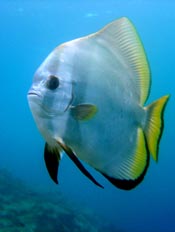Designing the Exhibit
The design for the Sant Ocean Hall didn’t happen in one grand design session. Instead, it evolved over time from multiple concepts and exhibits. Join us and watch as we look at the Biodiversity Display exhibit as an example. You’ll have a peek at this exhibit’s behind-the-scenes evolution.

- Original bubble plan for the ocean hall. Image courtesy: Smithsonian Institution, National Museum of Natural History
In this diagram, you can see how designers have placed the general concepts that will be covered in the ocean hall. Each area shows a broad idea and the amount of space that will be devoted to it, but little more than that. Here you can see that the Biodiversity Display is not yet named, but biodiversity is listed as one of the themes to be covered in “The Ocean: Essential to Life” area.

- Preliminary artistic rendering of the biodiversity display. Image courtesy: Smithsonian Institution, National Museum of Natural History
In this artist’s rendering, you can see an initial design for the shape and feeling of the Biodiversity Display. Specimens and models are displayed on a large, curved, ribbed structure, and video pods on the floor allow visitors to look down into the depths below.

- Preliminary artistic rendering of the biodiversity display. Image courtesy: Smithsonian Institution, National Museum of Natural History
In these design drawings, you can see the emerging shape of the Biodiversity Display. The large rib-like structure has disappeared, replaced by glass panels with curved tops. Specimen canisters have been placed outside the main structure, for viewing ease and access by museum workers. The floor video pods are still present, and some ideas for displaying groups of specimens are shown.

- The Biodiversity Display in greater detail. Image courtesy: Smithsonian Institution, National Museum of Natural History
Here, some of the glass panels have changed shape. Specimen layouts have become more detailed and individual specimens are placed next to the graphic panels that will interpret them. Some of the actual language and colors to be used on the graphics is included – though that is still evolving.
Bet you can’t wait to see the final product!
[ TOP ]
